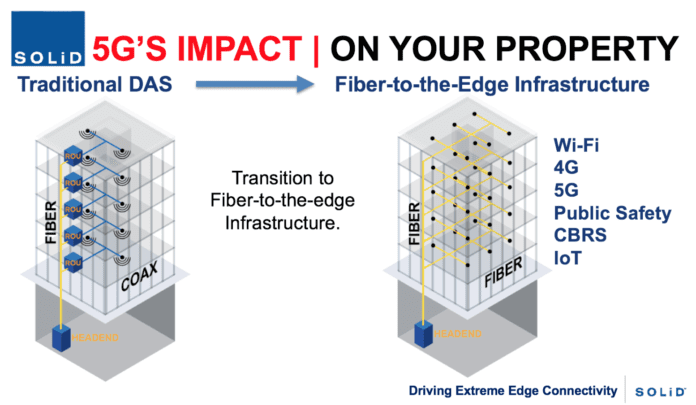Network densification is about a lot more than beefing up macro sites and deploying new small cells. Connecting all of these radio sites and tying them back into the core, data centers and other ICT locations, is fiber optic cabling. And, given current and future densification needs, fiber to the edge is today and will continue to be a sound investment, according to Tim Moynihan, senior vice president of marketing at SOLiD.
SOLiD’s parent company is based in Korea, a fiber-deep market with one of the highest rates of mobile penetration in the world. The country’s three mobile network operators used a shared infrastructure model to deploy 5G, which became commercially available in April. Moynihan discussed learnings from Korea that are applicable to build out of 5G in the U.S.
“Seoul is one of the densest cities in the world–twice as dense as New York City. The number of antennas, repeaters and things like that, the amount of gear, has probably been underestimated about what’s needed. The number of antennas and things that are going to drive those antennas, it’s a concern, but they’re being installed.” Related to 5G, the big question he said is “How do you deploy this–not just mass coverage. How are the operators going to be working together? Are they going to be competing, are they going to be cooperating? Just the sheer volume of equipment is something we’re all going to have to think, as an industry, about, particularly the operators. I think it’s one of the driving challenges of our industry at this point.”
Back to the fiber point, one of SOLiD’s focuses is provisioning in-building systems. Whether the buyer is an operator or a building owner, fiber is the common denominator. Moynihan observed a shift from a DAS point of view to “a much more fiber-oriented point of view,” given that a robust fiber infrastructure can support LTE, 5G, internet of things projects, CBRS in the U.S., public safety and outdoor applications.
“When we’re talking to potential customers and building owners, this is part of our checklist–to ensure the infrastructure supports 5G. It’s really about fiber,” Moynihan said.
He also called out a major trend that’s rippling through the telecom infrastructure vendor community with the support of many leading global operators–virtualization. Specific to the radio access network, groups like the O-RAN Alliance are working to develop open interfaces and standards with the long term goal of switching out single-purpose, proprietary boxes for general purpose equipment loaded up with software that virtually recreates the necessary network function.
“Our view is that organizations like the O-RAN Alliance and others that we’re very active in, building and developing software-based interfaces…based on open standards are really going to be what drives the industry and what makes 5G/4G connectivity happen.”
Q: Does the density that’s really needed in these urban networks justify a neutral host-type model or tighter collaboration between operators?
A: “I think that we’re going to have to see how it plays out. How is the cooperation between the operators going to happen? How are they going to be handling potentially other operators spectrum? How is the neutral host model going to play out? How are new business models going to play out? How is equipment potentially going to be shared? There’re a lot of things to consider as this is going forward. The demand seems to be nearly insatiable and I think in a lot of ways we’re underestimating the volume of equipment, the type of equipment and I think it’s going to drive us into some of these new kind of cooperative agreements in the future. If it doesn’t, I think it’s going to be very kludgy and not satisfying to any subscribers.”
Q: What’s the outlook on using millimeter wave frequencies to provide in-building connectivity?
A: “There is a play for millimeter wave in certain environments, in certain use cases–semi-indoor, semi-outdoor, stadiums, airports, these kind of places where millimeter wave will co-exist with 4G. We’re hearing calls from our customers for these types of solutions. At SOLiD, we’re looking at how 4G and 5G millimeter wave-type applications are going to co-exist, offer potentially different levels of service and really what the use case is. That’s one of the things customers are asking and we’re discussing with them is what are the use cases? Is there an opportunity to provide better service to the subscribers or is there a view we’re going to be charging additional premium for these kind of services, is there an expectation from the operator that ARPU will increase with these types of services. We definitely see there’ll be a mix of millimeter wave and traditional 4G-type coverage and capacity. There’s a lot of discussion around it right now but I think fundamentally it comes down to use case, subscriber experience and satisfaction, and potential for ARPU increases.”
Q: What’s the correlation between the move toward RAN virtualization and the densification requirements expected as 5G scales?
A: “I think virtualization, software-based solutions and open standards are going to be the direction this industry and all of us are going to have to get comfortable with and take to provide the level of density and level of increased capacity and coverage required to satisfy the demand. Demand keeps going up faster than we could ever envision. We are going to have to get a mode of virtualization and open standards and I think that things like flexibility of the networks, management of the networks, analytics, all these kind of things, not only the fundamental operation of the networks, are going to move in that direction as we move forward. Equipment is expensive. It takes up real estate in buildings or in data centers or operation centers and as we continue to grow we’re going to have to move to a much more software-oriented approach supplying the technology we provide today in hardware. It’ll increase capacity, it’ll drive down operational costs and can potentially drive down overall costs.”

